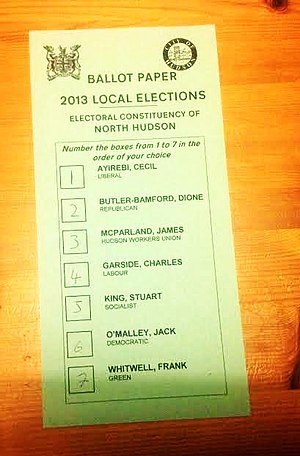
Back رأی خرکی Persian Szamárszavazat Hungarian Ավանակի քվեարկություն Armenian 당나귀 투표 Korean Donkey vote SIMPLE
This article has multiple issues. Please help improve it or discuss these issues on the talk page. (Learn how and when to remove these template messages)
|

| Part of the Politics series |
| Voting |
|---|
|
|
In electoral systems which use ranked voting, a donkey vote is a cast ballot where the voter ranks the candidates based on the order they appear on the ballot itself. The voter that votes in this manner is referred to as a donkey voter.
Typically, this involves numbering the candidates in the order they appear on the ballot paper: first preference for the first-listed candidate, second preference for the second-listed candidate, and so on. However, donkey votes can also occur in reverse, such that someone numbers the candidates from the bottom up the ballot paper. In systems where a voter is required to place a number against each candidate for the vote to be valid, the voter may give the first preference to the candidate they prefer, then run all the other numbers donkey fashion.
Donkey votes are most common where preference voting is combined with compulsory voting, such as in Australia, particularly where all candidates must be ranked on the ballot paper. There are different versions of the phenomenon applicable in the Parliament of Australia and in the Australian jurisdictions that use the Hare–Clark electoral system.
Donkey votes may occur for several reasons, including voter apathy, protest voting, simplicity on how-to-vote cards, the complexity of the voting system, or voter ignorance of the voting system rules. Occasionally, what appears as a donkey vote may in fact be a genuine representation of a voter's preferences.
© MMXXIII Rich X Search. We shall prevail. All rights reserved. Rich X Search